
The Lady of the Lake is a name or a title used by several either fairy or fairy-like but human enchantresses in the Matter of Britain, the body of medieval literature and mythology associated with the legend of King Arthur. She plays several important roles in many stories, including providing Arthur with the sword Excalibur, eliminating Merlin, raising Lancelot after the death of his father, and helping to take the dying Arthur to Avalon. Different sorceresses known as the Lady of the Lake appear concurrently as separate characters in some versions of the legend since at least the Post-Vulgate Cycle and consequently the seminal Le Morte d'Arthur, with the latter describing them as a hierarchical group, while some texts also give this title to either Morgan or her sister.
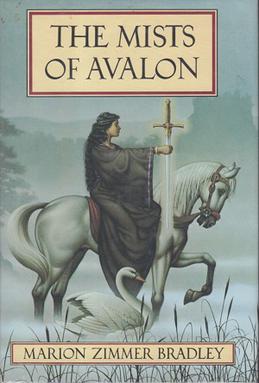
The Mists of Avalon is a 1983 historical fantasy novel by American writer Marion Zimmer Bradley, in which the author relates the Arthurian legends from the perspective of the female characters. The book follows the trajectory of Morgaine, a priestess fighting to save her Celtic religion in a country where Christianity threatens to destroy the pagan way of life. The epic is focused on the lives of Morgaine, Gwenhwyfar (Guinevere), Viviane, Morgause, Igraine and other women of the Arthurian legend.
The Queen of Orkney, today best known as Morgause and also known as Morgawse and other spellings and names, is a character in Arthurian legend in which she is the mother of Gawain and Mordred, both key players in the story of King Arthur and his downfall. In early texts, Mordred's father is her husband, King Lot of Orkney, with whom she may also have various other children. In later versions, including the seminal Le Morte d'Arthur, Mordred is the offspring of Arthur's accidental incest with Morgause, his estranged half-sister. There, she is furthermore a sister of Morgan le Fay, as well as the mother of Gareth, Agravain, and Gaheris, the last of whom murders her.

Etrigan the Demon is an antihero appearing in American comic books published by DC Comics. Created by Jack Kirby, Etrigan is a demon from Hell who, despite his violent tendencies, usually finds himself allied with the forces of good, mainly because of the alliance between the heroic characters of the DC Universe and Jason Blood, a human to whom Etrigan is bound. Etrigan is commonly depicted as a muscular humanoid creature with orange or yellow skin, horns, red eyes, and pointed, webbed ears, who frequently speaks in rhymes. The character was originally based in Gotham City, leading to numerous team-ups with Batman.
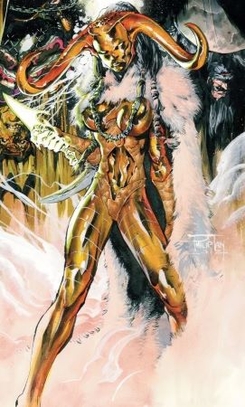
Morgaine le Fey is a supervillainess appearing in DC Comics, based on Morgan le Fay, the mythical sorceress and half-sister of King Arthur. She debuted in The Demon vol. 1 #1, and was created by Jack Kirby.

Merlin is a 1998 two-part television miniseries starring Sam Neill as Merlin, recounting the wizard's life in the mythic history of Britain. Loosely adapted from the legendary tales of Camelot, the plot adds the antagonistic Queen Mab and expands Merlin's backstory before the birth of King Arthur.
This is a bibliography of works about King Arthur, his family, his friends or his enemies. This bibliography includes works that are notable or are by notable authors.
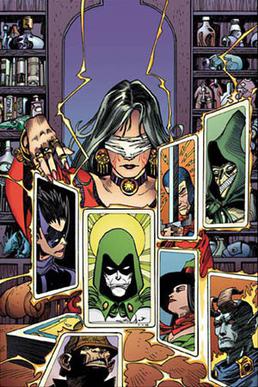
Madame Xanadu is a comic book mystic published by DC Comics. The character is identified with Nimue, the sorceress from Arthurian mythology made popular by Sir Thomas Malory's Le Morte d'Arthur.

Princess Gwenevere and the Jewel Riders, also known outside of North America as Starla & the Jewel Riders, is an American comic fantasy-themed animated television series aimed at pre-teen girl audiences and produced by Bohbot Entertainment in association with Hong Ying Animation Company Limited. It was internationally syndicated by Bohbot on their Syndicated Amazin' Adventures block, where it originally ran for two 13-episode seasons from 1995 until 1996. The show's plot follows the quest of the eponymous young Princess Gwenevere of Avalon and her two fellow teenage Jewel Riders, Fallon and Tamara, to find the seven lost enchanted jewels so they can stop the evil sorceress Lady Kale from taking over the kingdom. In the second season, the Jewel Riders receive more powers to compete against the returning Kale and the mighty new enemy Morgana for more magical jewels in order to rescue their banished mentor Merlin and restore harmony in magic.

The Mists of Avalon is a 2001 television miniseries based on the 1983 novel of the same title by Marion Zimmer Bradley. Produced by American cable channel TNT, adapted by Gavin Scott, and directed by Uli Edel, the series is a retelling of the Arthurian legend with an emphasis on the perspectives of Morgan le Fay and other women of the tale. The first episode was the highest-rated original movie on basic cable in the summer of 2001.

Avalon, also known as Otherworld, is a fictional dimension appearing in American comic books published by Marvel Comics. It is based on the mythical Avalon from Celtic and, more specifically, Welsh mythology.

Sir Percy of Scandia, also known as the original Black Knight, is a fictional character appearing in American comic books published by Marvel Comics. He was a medieval knight created by writer-editor Stan Lee and artist Joe Maneely.
The mythical wizard Merlin is featured as a character in numerous works of fiction, especially those based on Arthurian legends. Modern media frequently reimagines Merlin, and the Arthurian mythos more generally, changing Merlin's age, allegiances, family, and personal history.
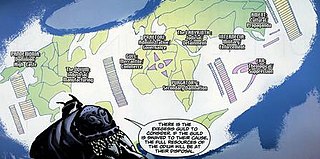
Hell is a fictional location, an infernal Underworld utilized in various American comic book stories published by DC Comics. It is the locational antithesis of the Silver City in Heaven. The DC Comics location known as Hell is heavily based on its depiction in Abrahamic mythology. Although several versions of Hell had briefly appeared in other DC Comics publications in the past, the official DC Comics concept of Hell was first properly established when it was mentioned in The Saga of the Swamp Thing #25–27 and was first seen in Swamp Thing Annual #2 (1985), all of which were written by Alan Moore and illustrated by Stephen Bissette and John Totleben.
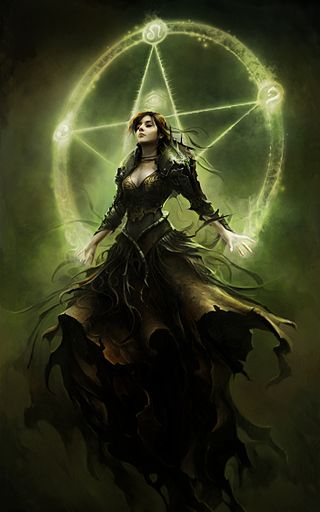
The Matter of Britain character Morgan le Fay has been featured many times in various works of modern culture, often but not always appearing in villainous roles. Some modern stories merge Morgana's character with her sister Morgause or with aspects of Nimue. Her manifestations and the roles given to her by modern authors vary greatly, but typically she is being portrayed as a villainess associated with Mordred.

King Arthur(Arthur Pendragon) is a legendary figure used commonly in comic books.
Merlin is a legendary character who has appeared multiple times throughout comic books especially in DC Comics and Marvel Comics.
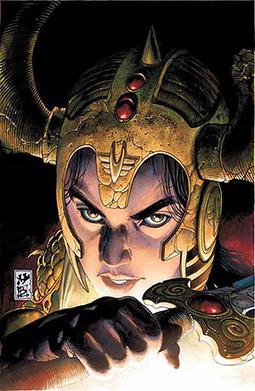
Shining Knight (Ystina) is a fictional character from DC Comics. He is the third character named Shining Knight and appears as a major character from Seven Soldiers. In The New 52 reboot, the character is reimagined as transgender.














